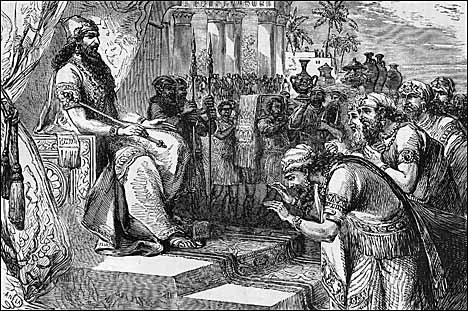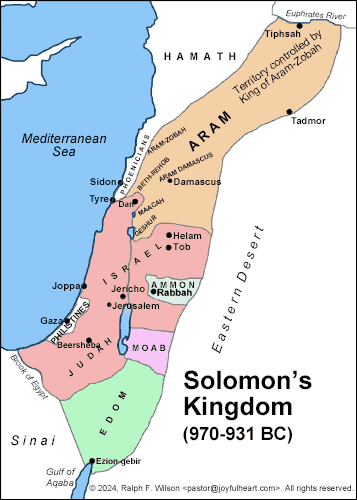
|
Old Testament
New Testament
Gospels
Acts
Paul's Letters
General Letters
Revelation
Topical Studies
Beginning the Journey (for new Christians). en Español

|
Old Testament
New Testament
Gospels
Acts
Paul's Letters
General Letters
Revelation
Topical Studies

|
Home
Bible Studies
Articles
Books
Podcasts
Search
Menu
Donate
About Us
Contact Us
FAQ
Sitemap

James Dabney McCabe, 's olomon Receiving Envoys of the Tributary Nations' (1877), in The Pictorial History of the World (National Publishing Company, 1877). Larger image.
Before we get into studying Solomon the man, it's best to deal with some of the overall, general issues of Solomon's times and the Books of the Bible that tell his story.
Absolute Monarchy
We need to understand Solomon within his context as an Iron Age absolute monarch -- actually an emperor, a king over other vassal kings in his empire. There is no distinction between the king's personal expense account and the national treasury. The king can spend whatever he wants on whatever he desires.
If we try to understand his political skill by standards of democracy, we'll err. If we try to understand his actions by adherence to Jesus' teachings, we'll fail. We need to try to understand him as a man of his time, not of our time. Only if we do that, can we see the universal principles that we can learn from.
Political Situation during Solomon's Reign (970-931 BC)
Solomon's father David is a man of war, carving out a substantial empire from the nations around Israel. Solomon, on the other hand, is a man of peace. There are two reasons for this:
- There are no major world powers moving to exercise dominance in the Near East during this period, and
- David has already subdued the nations adjoining Israel. All Solomon needs to do is maintain the status quo.
 Solomon's Kingdom (970-931 BC) (larger map) |
We'll get into all of this more deeply as we study the text, but, briefly, here is the status of the most powerful countries.
Egypt. To the south, Egypt is in the 21st Dynasty, a period of decline and political instability, unable to exercise power beyond its traditional borders.
Phoenicia. The Phoenician cities -- Tyre and Sidon -- are conducting an increasingly prosperous trade throughout the Mediterranean, but are allies and vassals of Israel, not enemies.
Mesopotamia. In Solomon's day the Arameans or Syrians are no longer a threat and have been subjugated by alliances with Israel.1 The Assyrians and Babylonians won't rise to ascendency until centuries later.2
Source Materials
Archeological evidence of Solomon's reign is scant at this point in time. (See Appendix 4. Archaeology of Solomon's Era.) Nevertheless, both Kings and Chronicles provide a good deal of information about David, Solomon, and their successors. Each of the Biblical sources comes with its own approach.
Martin Noth coined the term "Deuteronomistic History" in 1943 to refer to an historical work supposedly encompassing the biblical books of Deuteronomy through 2 Kings, since they seem to come from a similar viewpoint. Today, however, there are grave doubts about such a unified theory.3 I don't use the term in this book, but I mention it so you can be familiar with it.
"Chronicler's History" is a term that refers to the books of 1 and 2 Chronicles, Ezra, and Nehemiah and assumes that they originally constituted a single work. This theory, too, has been questioned.4 I don't assume a single author for all these books. However, I use the term "the Chronicler" to differentiate between the history as recorded in 1 Kings and the supplemental material recorded in 2 Chronicles.
Brief Introduction to Kings
Most of our source material on Solomon's life is found in the book of 1 Kings. 1 and 2 Kings follow 1 and 2 Samuel as part of a single narrative. The books of Samuel cover the history of Israel from the time of the prophet Samuel through the reign of David. The books of Kings cover the period from David's death and Solomon's accession, the break-up of the united kingdom, and accounts of the kings of both Israel in the north and Judah in the south, through the exile to Babylon. Originally, Kings was a single book in the Hebrew canon, broken into 1 and 2 Kings for convenience in the Middle Ages.
Kings tells us that it is compiled from a variety of sources that have been drawn together to produce a new work with a coherent message for its time. These sources include "the book of the acts of Solomon,"5 "the Book of the Chronicles of the Kings of Judah,"6 and "the Book of the Chronicles of the Kings of Israel."7 It is not unlikely that Kings had been edited and revised several times, perhaps in Josiah's time, then again during and after the exile.8 The exact formation of these books, however, isn't clear.9
When you study the dates of the various kings of Israel and Judah, you find that the period of a king's reign often includes an overlapping period of co-reign or co-regency with the king's father and/or the king's son, which makes dating challenging. The dating complexities were pretty well worked out by Seventh-day Adventist missionary and Old Testament scholar Edwin R. Thiele (1895-1986) in the mid-twentieth century.10
The purpose of Kings is basically theological and religious. In its final edition during the exile, it seems meant to establish Judah's faith in the Mosaic Law and the promises to David. As an account of the sins of the people, it helps explain the reason for the Exile that the people are experiencing.11
Brief Introduction to Chronicles
The Books of 1 and 2 Chronicles appear to have been written in the period following the exile and return to Judah, the Persian period (538 to 330 BC). Duke notes,
"The author(s), in a prophet-like manner, represents the community's past story from a post-exilic perspective with a focus on the role of David and the Davidic kings, the establishment of the proper temple cultus, and the need for kings and people to seek God."12
The issues the Chronicler faces are (1) the physical reconstitution of Israel within a Promised Land under Persian control, and (2) reestablishment of the temple and temple worship in Jerusalem. For inspiration, Chronicles looks back to the Golden Age of David and Solomon and the temple they built.
While Chronicles draws heavily on material in Kings, it shouldn't be seen as merely a supplement or a chronicle of events. "It retells Israelite history from a unique perspective, with its own themes and emphases."13 The Chronicler is especially interested in the organization of the priests and Levites in the regular worship in the temple. It omits most of the material that had to do with the northern kingdom of Israel.
One peculiarity of Chronicles is that, while Kings relates the sins and failings of David and Solomon, Chronicles includes but a single criticism of David, with regard to David taking a census14 and no criticisms of Solomon whatsoever.
Selman explains,
"In place of a history of Israel's monarchies, the Chronicler concentrates on the southern kingdom and on individual kings such as David, Solomon, or Hezekiah, though he also appears to adopt a more favorable attitude towards the north than the author of Kings. His preoccupation with specialist matters such as the temple, prayer, worship, and the Levites also indicates that his real interest lies outside the purely historical sphere."15
 Available in book formats - PDF, Kindle, Paperback |
Timeline
While dates are not firmly established during this period, here is a tentative timeline of events in Solomon's reign.16
| Solomon's birth | 991 BC | |
| Solomon's coronation as co-regent | 973/72 | |
| Solomon's sole rule | 971/70 | |
| Solomon's dream at Gibeon | 970 | |
| Started building the temple | 967/66 | |
| Solomon and Pharaoh Siamun | 967 | |
| Temple completed | 959 | |
| Palace completed | 946 | |
| Solomon dies, Rehoboam reigns | 931/30 | |
| Division of the kingdom | 931/30 | |
| Pharaoh Shoshenq I strips gold from temple and palace | 925 | |
| Northern kingdom deported by Assyria | 722 | |
| Temple destroyed by Babylonians | 587 | |
| Temple rebuilt after the Exile | 537-520 | |
| Temple remodeled by Herod the Great | 40 to 4 BC | |
| Temple destroyed by Romans | 70 AD |
Endnotes
[1] Later in Solomon's reign there is rebellion in Aram, Lesson 6.2.
[2] See review of the political situation in Kaiser and Wegner, History, pp. 396-399.
[3] S. L. Richter, "Deuteronomistic History," DOT:HB, 219-230.
[4] Some have attributed the books of 1 and 2 Chronicles, Ezra, and Nehemiah to an anonymous writer known simply as the Chronicler, hence, the term, "the Chronicler's History." The original theory was posited originally by L. Zunz (1832) and F. C. Movers (1834). More recently, due to the work of S. Japhet (1968) and H. G. M. Williamson (1977), the dominant view among scholars is that Chronicles and Ezra-Nehemiah are separate works (Martin J. Selman, "Chronicler's History," DOT:HB, 157-161)
[5] 1 Kings 11:41.
[6] 1 Kings 14:29; 15:7; 22:45; 2 Kings 14:18; 23:28; etc.
[7] 1 Kings 14:19; 15:31; 22:39; 2 Kings 14:15, 28; etc.
[8] Sandra L. Richter, "Deuteronomistic History," DOT:HB, pp. 219-230.
[9] Gwilym H. Jones (1 and 2 Kings (New Century Bible Commentary; Eerdmans, 1984), vol. 1, p. 29) comments that, "As far as the books of Kings are concerned, the general framework includes an evaluation of the rulers of Israel and Judah which is based on the criterion of cultic purity found in the book of Deuteronomy."
[10] E. R. Thiele, The Mysterious Numbers of the Hebrew Kings (1951, revised 1965, 1983).
[11] Information drawn primarily from Edward Ball, "Kings, Books of," ISBE 3:30-38.
[12] Rodney K. Duke, "Chronicles, Books of," DOT:HB, p. 161.
[13] Duke, "Chronicles, Books of" DOT:HB, p. 161.
[14] Perhaps this was included since it directly related to the location of the future temple; clearly, proper temple worship is a major theme of Chronicles (Duke, "Chronicles, Books of," DOT:HB, p. 173).
[15] Selman, 1 Chronicles, p. 21.
[16] Kaiser and Wegner, History, p. 395; J. N. Oswalt, "Chronology of the OT," ISBE 1:681. Bright's dates (History, pp. 491ff.) are about 10 years later.
Copyright © 2026, Ralph F. Wilson. <pastor![]() joyfulheart.com> All rights reserved. A single copy of this article is free. Do not put this on a website. See legal, copyright, and reprint information.
joyfulheart.com> All rights reserved. A single copy of this article is free. Do not put this on a website. See legal, copyright, and reprint information.

